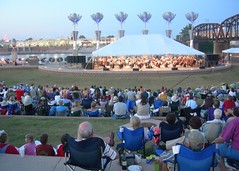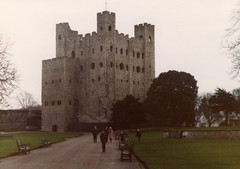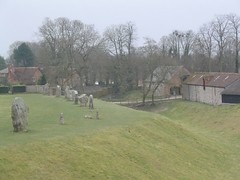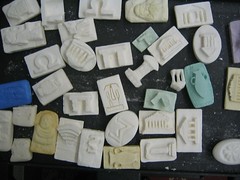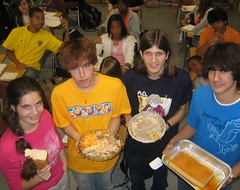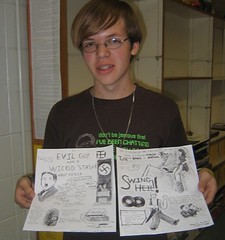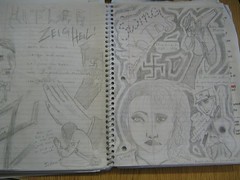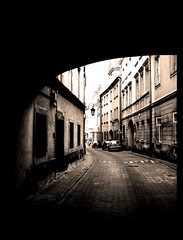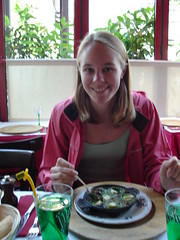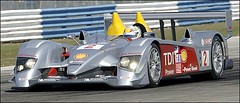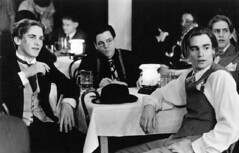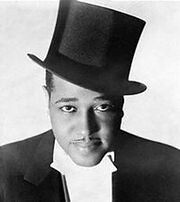Exams represent only one of the ways we measure intelligence and ability to learn. But testing is endemic to modern society. It is a skill to be cultivated.
Here are the top scorers - those past the 90% mark - in the open notes, multiple-choice section of the geography exam (everyone did well on the hand-sketched map of Western Europe, which was used as the source of points for a curved scale:
1st hr: Anuj Chaniyara
3rd hr: Latisha Williams, Blake Holloway, Ahmad Nawabi.
5th hr: Christina Howard, Jenny Owen, Joshua Atkins, India Davis, Adam West, Kendall Belcher, Michael Harb and the highest scorer overall: Charles Madden.
2nd hr: RJ Bowman, Rebecca Ebarb, James Hall and Craig Smith.
6th hr: Michelle Cardone, Colton Cowley and John Michael Provenza.
Congrats!
Tuesday, May 23, 2006
Monday, May 22, 2006
Semester exam: hand-sketched map & open notes, mult.-choice questions
Semester exam -
1. Hand-drawn map of Western Europe, 20 items. Your choice of nations, cities, bodies of water, mtns. and other sites studied in class.
2. Open notes section: you will have a Scantron sheet and 100 multiple-choice questions. Use a pencil, of course.
* You may use a web site print-out or the usual classroom resources - textbook, dictionaries, encyclopedia, etc. You may not use a computer.
* Questions will be drawn from each of the units we've had since January.
* All questions are from tests we've covered this semester.
* No communication of any sort during the exam! 20 pt. penalty for violating the guidelines. Quietly check with me on any and all concerns.
Portfolios are still being graded - it's a 15 pt assignment - and still being accepted. Submitting a late project is far better than ignoring it.
* Extra credit work period ended May 18.
Questions? trudeau@earthlink.net
1. Hand-drawn map of Western Europe, 20 items. Your choice of nations, cities, bodies of water, mtns. and other sites studied in class.
2. Open notes section: you will have a Scantron sheet and 100 multiple-choice questions. Use a pencil, of course.
* You may use a web site print-out or the usual classroom resources - textbook, dictionaries, encyclopedia, etc. You may not use a computer.
* Questions will be drawn from each of the units we've had since January.
* All questions are from tests we've covered this semester.
* No communication of any sort during the exam! 20 pt. penalty for violating the guidelines. Quietly check with me on any and all concerns.
Portfolios are still being graded - it's a 15 pt assignment - and still being accepted. Submitting a late project is far better than ignoring it.
* Extra credit work period ended May 18.
Questions? trudeau@earthlink.net
Friday, May 19, 2006
Symbolism in the medieval gowns worn at graduation
* Commencement: a beginning
* mortar board: masons
* skull cap: scholars, the devout of many faiths
* gown: monk-like garb, scholar's garb.
* vale - Latin: "goodbye." valedictorian gives the goodbye speech.
* salut: L: "hello." salutatorian gives hello speech.
* cum laude - Latin: with honors.
* magna cum laude: with great honors
* summa cum laude: highest honors
* capuch / monk's hood: hanging on back of faculty academic gown. colors in stylized hood denote college and field of study.
* sleeves' length indicate higher degrees.
Anyone remember the young mogul Larry Page? Why is this man addressing grads at the U of Michigan, a high-status school?
* mortar board: masons
* skull cap: scholars, the devout of many faiths
* gown: monk-like garb, scholar's garb.
* vale - Latin: "goodbye." valedictorian gives the goodbye speech.
* salut: L: "hello." salutatorian gives hello speech.
* cum laude - Latin: with honors.
* magna cum laude: with great honors
* summa cum laude: highest honors
* capuch / monk's hood: hanging on back of faculty academic gown. colors in stylized hood denote college and field of study.
* sleeves' length indicate higher degrees.
Anyone remember the young mogul Larry Page? Why is this man addressing grads at the U of Michigan, a high-status school?
Thursday, May 18, 2006
Castles: an overview of medieval European life
English castles! There were lots of them. Mighty stone cathedrals, too.
The castle design was influenced by lessons in the Crusades - in the early 1200's. Knights fought the Muslims and got effective ideas for fortifications in Syria and Palestine.
* portcullis - fortified door
* drawbar - behind the door
* gatehouses
* crennelations - tops of walls offered cover to soldiers (see above)
* finials - pointy decorations atop walls, etc.
* arrow loop - slot thru which archers fired
* inner ward: chapel, nobles' apartments, great hall, barracks & stables, kitchen & well, blacksmith shop, storehouses.
* inner & outer curtain - stone walls
The forces that swept into Celtic England and made the British an amalgam:
* Normans - from Normandy, France
* Angles & Saxons - from Germany (Angle Land - England)
* Norse - Danes, Norwegians, Swedes (Scandinavians)
* Romans - from Italy.
The castle design was influenced by lessons in the Crusades - in the early 1200's. Knights fought the Muslims and got effective ideas for fortifications in Syria and Palestine.
* portcullis - fortified door
* drawbar - behind the door
* gatehouses
* crennelations - tops of walls offered cover to soldiers (see above)
* finials - pointy decorations atop walls, etc.
* arrow loop - slot thru which archers fired
* inner ward: chapel, nobles' apartments, great hall, barracks & stables, kitchen & well, blacksmith shop, storehouses.
* inner & outer curtain - stone walls
The forces that swept into Celtic England and made the British an amalgam:
* Normans - from Normandy, France
* Angles & Saxons - from Germany (Angle Land - England)
* Norse - Danes, Norwegians, Swedes (Scandinavians)
* Romans - from Italy.
Summer movies on England: the Beatles and the 60's
Highly recommended for fun and cultural awareness:
A Hard Days Night (1966) reveals the thick Liverpudlian accents of the Beatles, who had lower-middle class origins. It's a silly sort of extended music video - in B/W - but it has charming moments and offers insights into the zeitgeist of the mid 1060's in England.
Help! was the Beatles second flic. It, too, has plenty of colorful Britishisms. It also features considerable travel (Bahamas, Switzerland).
Recommended!
Also based on the smartly-crefted songs of the Beatles was an animated film, Yellow Submarine. It is a marvelous pin-wheely vision of the psychedelic art style. Yellow Submarine is undoubtedly too lengthy, but it is stunning in its fist 45 minutes. Also recommended.
A Hard Days Night (1966) reveals the thick Liverpudlian accents of the Beatles, who had lower-middle class origins. It's a silly sort of extended music video - in B/W - but it has charming moments and offers insights into the zeitgeist of the mid 1060's in England.
Help! was the Beatles second flic. It, too, has plenty of colorful Britishisms. It also features considerable travel (Bahamas, Switzerland).
Recommended!
Also based on the smartly-crefted songs of the Beatles was an animated film, Yellow Submarine. It is a marvelous pin-wheely vision of the psychedelic art style. Yellow Submarine is undoubtedly too lengthy, but it is stunning in its fist 45 minutes. Also recommended.
Tuesday, May 16, 2006
Avebury Stone Circle: "largest known stone circle in the world"
Stonehenge Project - 10 pts. - due Wed:
1) Map that shows Wales, Stonehenge and related sites and bodies of water.
2) Terminology of Stonehenge construction. Ex: mortise & tenon, lintel, dolerite.
3) Sketch of the elements of the Stonehenge site.
4) Color, sources, title.
5) Mult-choice questions, 5 of them.
* ley lines
* Merlin the Magician / King Arthur
* bank & ditch
1) Map that shows Wales, Stonehenge and related sites and bodies of water.
2) Terminology of Stonehenge construction. Ex: mortise & tenon, lintel, dolerite.
3) Sketch of the elements of the Stonehenge site.
4) Color, sources, title.
5) Mult-choice questions, 5 of them.
* ley lines
* Merlin the Magician / King Arthur
* bank & ditch
Monday, May 15, 2006
Stonehenge: created 5000 years ago in Southern England, in part with Blue Stones from Wales
Historians have speculated that Stonehenge was
1) "a temple made for the worship of ancient earth deities."
2) "an astronomical observatory for marking significant events on the prehistoric calendar."
3) "a sacred site for the burial of high-ranking citizens from the societies of long ago,"says brittania.com.
Please see Stonehenge.
The site originally comprised a large bank and precisely circular ditch, called by the British a "henge." The earliest construction dates to about 5000 years ago. Henges were constructed - with ditch, bank and poles - all across Britain in the Neolithic and Mesolithic periods (the Stone Age).
Stage 2 of construction: 82 Blue stones - about 4 tons each - were transported from the Prescelly Mtns. of Wales (about 240 miles). Within the outer circle of 60 stones were two horseshoe-shaped assemblages of stones.
Stage 3 saw the transportation of 77 Sarsen stones of 26 to 40 tons each from about 20 miles away. The Sarsen stones are the ones apparent in photos of Stonehenge. The Sarsens were dressed (rubbed smooth) and notched. Lintel stones were laid across the tops of this giant circle of vertical stones in mortise and tenon construction.
The 3-stone (2 posts and a lintel) groups are called trilithons. The large outside ring of trilithons would have been about 16 ft high. Inside the ring was a horseshoe-shaped group of trilithons. These stones were the largest: some 50 tons each and as high as 24 ft., says Wikipedia.org.
Independent work: Comparing Stonehenge and the nearby Avebury ring.
1) "a temple made for the worship of ancient earth deities."
2) "an astronomical observatory for marking significant events on the prehistoric calendar."
3) "a sacred site for the burial of high-ranking citizens from the societies of long ago,"says brittania.com.
Please see Stonehenge.
The site originally comprised a large bank and precisely circular ditch, called by the British a "henge." The earliest construction dates to about 5000 years ago. Henges were constructed - with ditch, bank and poles - all across Britain in the Neolithic and Mesolithic periods (the Stone Age).
Stage 2 of construction: 82 Blue stones - about 4 tons each - were transported from the Prescelly Mtns. of Wales (about 240 miles). Within the outer circle of 60 stones were two horseshoe-shaped assemblages of stones.
Stage 3 saw the transportation of 77 Sarsen stones of 26 to 40 tons each from about 20 miles away. The Sarsen stones are the ones apparent in photos of Stonehenge. The Sarsens were dressed (rubbed smooth) and notched. Lintel stones were laid across the tops of this giant circle of vertical stones in mortise and tenon construction.
The 3-stone (2 posts and a lintel) groups are called trilithons. The large outside ring of trilithons would have been about 16 ft high. Inside the ring was a horseshoe-shaped group of trilithons. These stones were the largest: some 50 tons each and as high as 24 ft., says Wikipedia.org.
Independent work: Comparing Stonehenge and the nearby Avebury ring.
Sunday, May 14, 2006
Greek motifs in a study of relief sculpture in geo class
Some of the more fluent examples of soap sculpture are seen in this display of student relief carving.
* What elements can you see that make a connection with classical Greek culture?
* Are there items in this group of sculptures that could be Latin?
* What's the difference between sculpture and relief sculpture?
* What elements can you see that make a connection with classical Greek culture?
* Are there items in this group of sculptures that could be Latin?
* What's the difference between sculpture and relief sculpture?
A quiche for the study of France in geography class (a Cuban flan, too)
kaitlyn Kehoe, Stephen Clark, Blake Holloway and Raciel Pintado were among a number of students who cooked dishes to serve to class mates. Kaitlyn, by the way, is holding a chunk of French bread. There's a relationship between the quiche and the Cuban flan: both are essentially egg custards.
We discovered that the quiche, associated with French cooking, also has Deutsche roots. The German word kuchen is the basis for quiche. The region of Lorraine, home to quiche, is a Rhine region that has been both German and French over its history.
We discovered that the quiche, associated with French cooking, also has Deutsche roots. The German word kuchen is the basis for quiche. The region of Lorraine, home to quiche, is a Rhine region that has been both German and French over its history.
Friday, May 12, 2006
Swing Kids report illustrated by Charles Madden
Illustrated summaries of the movie Swing Kids and Hitler's reign, or the Third Reich, were produced this week. Here's an example of work that will go into a digital portfolio. Please email me a link to your portgolio as soon as you've completed it.
Illustrated report by Aimee Louviere on the movie Swing Kids
This week students created illustrated reports on Swing Kids as well as on Hitler's Reich. Many also created parent or classmate quizzes and won bonus points.
Tuesday, May 09, 2006
Illustrated page on Hitler in Europe
Due Thursday: Illustrated Notes projects
a) one page on Hitler
b) one page of Swing Kids (see more below)
* Combine notes on the Hitler timeline and the Nazi invasion of Europe.
* Add 5 illustrations.
* Projects are to be scored at 6 pts each.
* Add titling, check for spelling.
* To be kept in your notebook.
* Audience: parents or siblings or peers.
This illustration is of the Warsaw, Poland, ghetto. The Nazis allowed the warsaw ghetto to exist for several years before the people were exterminated (see Schindler's List).
a) one page on Hitler
b) one page of Swing Kids (see more below)
* Combine notes on the Hitler timeline and the Nazi invasion of Europe.
* Add 5 illustrations.
* Projects are to be scored at 6 pts each.
* Add titling, check for spelling.
* To be kept in your notebook.
* Audience: parents or siblings or peers.
This illustration is of the Warsaw, Poland, ghetto. The Nazis allowed the warsaw ghetto to exist for several years before the people were exterminated (see Schindler's List).
Josef Mengele, brutal medical experiments on inmates at Auschwitz death camp
Josef Mengele (March 16, 1911 – February 7, 1979), acc to Wikipedia.com, was a Nazi German SS officer and a physician in the concentration camp Auschwitz (Poland). He gained notoriety chiefly for being one of the SS physicians that would supervise the selection of arriving transports, determining who was to be sent directly to the gas chambers and who was to become a prisoner, and for performing brutal experiments of dubious scientific value on camp inmates.
After the war he escaped Germany through a variety of ruses and subterfuges and lived covertly abroad until his eventual accidental death in Brazil, which was later confirmed using DNA testing on his remains.
One quotation attributed to him was "The more we do to you, the less you believe we're doing it." He also adhered to Hitler's concept of the big lie, stating, "The greater the falsehood we tell you the more completely you will believe it."
He later became known as the Todesengel (Angel of Death) of the Auschwitz concentration camp.
After the war he escaped Germany through a variety of ruses and subterfuges and lived covertly abroad until his eventual accidental death in Brazil, which was later confirmed using DNA testing on his remains.
One quotation attributed to him was "The more we do to you, the less you believe we're doing it." He also adhered to Hitler's concept of the big lie, stating, "The greater the falsehood we tell you the more completely you will believe it."
He later became known as the Todesengel (Angel of Death) of the Auschwitz concentration camp.
Project: Two Illustrated Pages on Europe in WWII
As a culminating activity re the movie Swing Kids I want you to create a page with 5 graphics (clip art, sketches, etc) surrounding notes on the movie.
Here are basic notes:
* "His voice of hate. His promises of glory." a letter by Peter Muller's father in regards Germans opposing Hitler.
* We are not in charge. We cannot know what's really going on." Thomas Berger in regards understanding the Nazis' murderious activities.
* "You must steel yourself." Muller's mother on how to survive the brutality of the nazi regime.
* "I was once like you." Gestapo officer Knopp in his effort to get Peter to convert to Nazism.
* "We are murdering Austrians, Poles and Czechs." Arvid, the musician, on the silence of the German people in the face of Nazi atrocities.
* 1939 - 1940 timeframe of the movie.
* Hamburg, the site of the story (though filmed in Prague, Czechoslovakia).
* Swing kids:
- resist joining the Hitler Jugend
- Listen & dance to jazz, smuggle in jazz records.
- long hair, English-style clothes.
- anti-Nazi.
* "It don't mean a thing if it ain't got that swing." tune by jazz bandleader Duke Ellington.
Here are basic notes:
* "His voice of hate. His promises of glory." a letter by Peter Muller's father in regards Germans opposing Hitler.
* We are not in charge. We cannot know what's really going on." Thomas Berger in regards understanding the Nazis' murderious activities.
* "You must steel yourself." Muller's mother on how to survive the brutality of the nazi regime.
* "I was once like you." Gestapo officer Knopp in his effort to get Peter to convert to Nazism.
* "We are murdering Austrians, Poles and Czechs." Arvid, the musician, on the silence of the German people in the face of Nazi atrocities.
* 1939 - 1940 timeframe of the movie.
* Hamburg, the site of the story (though filmed in Prague, Czechoslovakia).
* Swing kids:
- resist joining the Hitler Jugend
- Listen & dance to jazz, smuggle in jazz records.
- long hair, English-style clothes.
- anti-Nazi.
* "It don't mean a thing if it ain't got that swing." tune by jazz bandleader Duke Ellington.
Monday, May 08, 2006
French cuisine and Seven French regions
* Escargots Burguignon: snails served in a garlic-butter sauce.
* fromage: cheese
* brie: a type of goat cheese
* mayonnaise: olive oil, eggs, lemon, etc.
* pomme de terre frites: french fries
* ecrevisses: crawfish
* boudin noir: rice-filled pork sausage - with congealed blood.
* pate de foie gras: liver paste; made of fattened goose livers.
* truffles: underground fungus
* boeuf Burguignon: beef stew with wine
* petit dejeuner : breakfast
* dejeuner: lunch (typically, 2 hours)
* le diner: supper (2 hrs later than American supper).
*pain perdu: French toast.
* quiche Lorraine: egg-cheese pie.
* Perrier: bottled water from France.
Regions -
* Normandy (D Day)
* Brittany (British immigrants)
* Bordeaux: wine & food region on the Atlantic side.
* Provence: Matisse and Picasso painted here.
* Cote d'Azur / French Riviera: expensive beaches.
* Burgundy: wine and cuisine region on the East.
* Champagne: part of Burgundy.
Additionally -
Pyrenees Mts. border between France & Espana.
Corsica: napoleon Bobaparte's home.
Strait of Dover: some 24 miles across.
English Channel: Dover to Calais.
Belgium: fabrics, waffles, oysters, beers.
Luxembourg: high standard of living.
Deutschland: traditional foe of the French.
Switzerland: banks, watches, chalets.
L'Italia: Nutella, autos, fabrics, the Renaissance.
Espana: Also part of the Roman Empire.
Thursday
* hand-sketched map of France and neighbors. Vocabulary quiz: France and Swing Kids.
Tues. Collage on the movie Swing Kids.
Wed. Performance day.
* fromage: cheese
* brie: a type of goat cheese
* mayonnaise: olive oil, eggs, lemon, etc.
* pomme de terre frites: french fries
* ecrevisses: crawfish
* boudin noir: rice-filled pork sausage - with congealed blood.
* pate de foie gras: liver paste; made of fattened goose livers.
* truffles: underground fungus
* boeuf Burguignon: beef stew with wine
* petit dejeuner : breakfast
* dejeuner: lunch (typically, 2 hours)
* le diner: supper (2 hrs later than American supper).
*pain perdu: French toast.
* quiche Lorraine: egg-cheese pie.
* Perrier: bottled water from France.
Regions -
* Normandy (D Day)
* Brittany (British immigrants)
* Bordeaux: wine & food region on the Atlantic side.
* Provence: Matisse and Picasso painted here.
* Cote d'Azur / French Riviera: expensive beaches.
* Burgundy: wine and cuisine region on the East.
* Champagne: part of Burgundy.
Additionally -
Pyrenees Mts. border between France & Espana.
Corsica: napoleon Bobaparte's home.
Strait of Dover: some 24 miles across.
English Channel: Dover to Calais.
Belgium: fabrics, waffles, oysters, beers.
Luxembourg: high standard of living.
Deutschland: traditional foe of the French.
Switzerland: banks, watches, chalets.
L'Italia: Nutella, autos, fabrics, the Renaissance.
Espana: Also part of the Roman Empire.
Thursday
* hand-sketched map of France and neighbors. Vocabulary quiz: France and Swing Kids.
Tues. Collage on the movie Swing Kids.
Wed. Performance day.
Saturday, May 06, 2006
Diesel-powered Audi wins Sebring Grand Prix
A NYTimes article entitled Remaking Diesel's Image a Lap at a Time says, "European roads are bustling with modern diesel cars that do not spew stinky clouds of black smoke from their tailpipes or announce their presence with a truck-stop clatter from under the hood. But with few exceptions, American drivers cannot buy these refined models.
Not that it matters. Buyers in the United States do not clamor for these thrifty cars anyway, largely because the diesels they have known were slow, quirky and not worth the fuss so long as gasoline was cheap.
But diesels are fast becoming much cooler, and much faster. Traditional diesel vices have been tamed by new technologies, and the latest Eurodiesels offer performance similar to that of gasoline-powered sport sedans. Further evidence of the diesel's performance potential came earlier this month, when the diesel-powered Audi R10 won the 12 Hours of Sebring sports car race in Florida.
Cleaning up diesels to meet American emissions standards cannot be accomplished with the same solutions used for gasoline engines. A conventional gasoline engine compresses a mixture of fuel and air, then ignites it with an electric spark just before the piston reaches the top of its stroke. How much the mixture can be squeezed — and therefore the fuel efficiency — is limited by the fuel's ability to resist detonation, or pinging.
A diesel engine, though, compresses air only, and can thus compress it much more, raising its temperature to several hundred degrees. As the piston reaches the top of its travel, fuel is sprayed into the cylinder by a high-pressure injector; after a short delay, it ignites spontaneously. In both types of engines, the pressure created by the heat of the burning fuel drives the piston downward in the cylinder to produce rotary mechanical power at the crankshaft.
The appeal of a diesel engine is its greater fuel economy, a gain of 25 to 40 percent. European regulators allow diesels to operate under less-strict emissions standards and the benefit of a lower fuel tax in return for their ability to reduce dependence on foreign oil.
More than half of European car buyers choose diesel engines. In the United States, diesel efficiency could also help to reduce fuel imports — or allow drivers to continue their romance with large cars and S.U.V.'s despite high fuel prices.
For a time in the 1980's diesels were attractive to buyers and regulators alike because they were so fuel-efficient and because their operation, with at least 20 percent more air than their fuel requires, suppressed hydrocarbon emissions. Then it was discovered that carbon particles in diesel exhaust carry chemicals linked to cancer.
Interest in diesels waned in the United States. But high fuel costs are again making diesels attractive, despite emissions rules that limit where they can be sold."
Not that it matters. Buyers in the United States do not clamor for these thrifty cars anyway, largely because the diesels they have known were slow, quirky and not worth the fuss so long as gasoline was cheap.
But diesels are fast becoming much cooler, and much faster. Traditional diesel vices have been tamed by new technologies, and the latest Eurodiesels offer performance similar to that of gasoline-powered sport sedans. Further evidence of the diesel's performance potential came earlier this month, when the diesel-powered Audi R10 won the 12 Hours of Sebring sports car race in Florida.
Cleaning up diesels to meet American emissions standards cannot be accomplished with the same solutions used for gasoline engines. A conventional gasoline engine compresses a mixture of fuel and air, then ignites it with an electric spark just before the piston reaches the top of its stroke. How much the mixture can be squeezed — and therefore the fuel efficiency — is limited by the fuel's ability to resist detonation, or pinging.
A diesel engine, though, compresses air only, and can thus compress it much more, raising its temperature to several hundred degrees. As the piston reaches the top of its travel, fuel is sprayed into the cylinder by a high-pressure injector; after a short delay, it ignites spontaneously. In both types of engines, the pressure created by the heat of the burning fuel drives the piston downward in the cylinder to produce rotary mechanical power at the crankshaft.
The appeal of a diesel engine is its greater fuel economy, a gain of 25 to 40 percent. European regulators allow diesels to operate under less-strict emissions standards and the benefit of a lower fuel tax in return for their ability to reduce dependence on foreign oil.
More than half of European car buyers choose diesel engines. In the United States, diesel efficiency could also help to reduce fuel imports — or allow drivers to continue their romance with large cars and S.U.V.'s despite high fuel prices.
For a time in the 1980's diesels were attractive to buyers and regulators alike because they were so fuel-efficient and because their operation, with at least 20 percent more air than their fuel requires, suppressed hydrocarbon emissions. Then it was discovered that carbon particles in diesel exhaust carry chemicals linked to cancer.
Interest in diesels waned in the United States. But high fuel costs are again making diesels attractive, despite emissions rules that limit where they can be sold."
Friday, May 05, 2006
Choreographer Otis Sallid: Swing Kids, Malcolm X, Smokey Joe's Cafe, etc
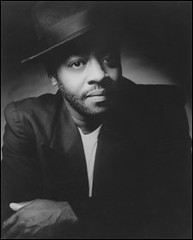
Choreographer Otis Sallid: Swing Kids, Malcolm X, Smokey Joe's Cafe, etc
Originally uploaded by trudeau.
Thursday, May 04, 2006
The industrial, seafaring nation on the North Sea and Baltic
Germany
Learn language basics at German Phrases. Example: "Auf wiedersehen!"
vocab:
verboten! forbidden
achtung! danger, or, warning
nacht night
Independent work
Research, compare and document an essay comparing 2 notable Germans, such as Adi Dassler and Albert Einstein.
Learn language basics at German Phrases. Example: "Auf wiedersehen!"
vocab:
verboten! forbidden
achtung! danger, or, warning
nacht night
Independent work
Research, compare and document an essay comparing 2 notable Germans, such as Adi Dassler and Albert Einstein.
Wednesday, May 03, 2006
Swing Kids (1993): a tale of resistance against the Nazis
Hamburg, 1939
The story of a close-knit group of young kids in Nazi Germany who listen to banned swing music from the US. Soon dancing and fun leads to more difficult choices as the Nazi's begin tightening the grip on Germany. Each member of the group is forced to face some tough choices about right, wrong, and survival, says IMDB.com.
Not all Deutsches cooperated with the Nazis. Many young Germans realized that the Fascist regime was corrupt and that the Nazi rule was demonic.
Students who loved jazz were considered rebels. Many of them realized the Nazi racist point of view was irrational.
Rejected along with Jews were African-Americans and their dancing and music (as well as Gypsies, Slavs, the handicapped, etc.).
Swing Kids presents us with a smooth-talking Gestapo agent played by actor Kenneth Branagh.
Who says, "You must learn to steel yourself," in regards cooperating with the Nazis? The hero's mother. She lost her husband to Nazi imprisonment and lived under nerve-wracking Gestapo observation for years.
See more about the actors and reviews of Swing Kids at http://www.imdb.com/title/tt0108265/
vocab -
Axis powers: Deutschland, L'Italia (both fascist), japan
Allied powers: Great Britain (GB), France, USA, Russia (despite a cooperation treaty, the Russians were invaded by Hitler; Russia recovered from their losses and helped defeat the German armies).
D-Day - Allied invasion of France.
Schindler's List is based on a true story; I recommend it highly. Saving Private Ryan is also
based on historically accurate material; also recommended.
Map quiz: 3 cities; the remaining 12 items must be neighboring nations and bodies of water.
Da; nyet. Ja; nein. Which languages?
Alte schule, real schule, gymnasium.
Albrecht Durer (1500), Renaissance artist in Germany. First to produce prints (via engraving) of his work and have them widely and inexpensively distributed. See Johann Gutenberg.
Maia: Roman goddess for which we have the month of May.
The story of a close-knit group of young kids in Nazi Germany who listen to banned swing music from the US. Soon dancing and fun leads to more difficult choices as the Nazi's begin tightening the grip on Germany. Each member of the group is forced to face some tough choices about right, wrong, and survival, says IMDB.com.
Not all Deutsches cooperated with the Nazis. Many young Germans realized that the Fascist regime was corrupt and that the Nazi rule was demonic.
Students who loved jazz were considered rebels. Many of them realized the Nazi racist point of view was irrational.
Rejected along with Jews were African-Americans and their dancing and music (as well as Gypsies, Slavs, the handicapped, etc.).
Swing Kids presents us with a smooth-talking Gestapo agent played by actor Kenneth Branagh.
Who says, "You must learn to steel yourself," in regards cooperating with the Nazis? The hero's mother. She lost her husband to Nazi imprisonment and lived under nerve-wracking Gestapo observation for years.
See more about the actors and reviews of Swing Kids at http://www.imdb.com/title/tt0108265/
vocab -
Axis powers: Deutschland, L'Italia (both fascist), japan
Allied powers: Great Britain (GB), France, USA, Russia (despite a cooperation treaty, the Russians were invaded by Hitler; Russia recovered from their losses and helped defeat the German armies).
D-Day - Allied invasion of France.
Schindler's List is based on a true story; I recommend it highly. Saving Private Ryan is also
based on historically accurate material; also recommended.
Map quiz: 3 cities; the remaining 12 items must be neighboring nations and bodies of water.
Da; nyet. Ja; nein. Which languages?
Alte schule, real schule, gymnasium.
Albrecht Durer (1500), Renaissance artist in Germany. First to produce prints (via engraving) of his work and have them widely and inexpensively distributed. See Johann Gutenberg.
Maia: Roman goddess for which we have the month of May.
Tuesday, May 02, 2006
Duke Ellington: swing jazz in Harlem moved people across the globe
Early Jazz - 1910's, 1920's
New Orleans: King Oliver, Louis Armstrong / brass band-influenced. "Hot music."
Chicago: Oliver, Armstrong, etc., making small group jazz in a ragtime style. Dancers loved it.
Swing jazz - 1930's, 1940's
NYC / Harlem: Armstrong, Duke Ellington, Cab Calloway, Benny Goodman, Count Basie, Tommy Dorsey, Gene Krupa.
Big bands made a big sound; dancers got wilder with the jitterbug and variations.
Cool jazz / bebop - 1950's, 1960's
NYC: Dizzy Gillespie, Miles Davis, etc. made complex jazz primarily for listening, not dancing.
Rock & roll - 1950's
Chuck Berry, Fats Domino, Bill Haley, Little Richard, etc. combined the blues and R & B with country music and came out with Rock/nRoll. Dancers began with the jitterbug and moved on to the twist, etc.
New Orleans: King Oliver, Louis Armstrong / brass band-influenced. "Hot music."
Chicago: Oliver, Armstrong, etc., making small group jazz in a ragtime style. Dancers loved it.
Swing jazz - 1930's, 1940's
NYC / Harlem: Armstrong, Duke Ellington, Cab Calloway, Benny Goodman, Count Basie, Tommy Dorsey, Gene Krupa.
Big bands made a big sound; dancers got wilder with the jitterbug and variations.
Cool jazz / bebop - 1950's, 1960's
NYC: Dizzy Gillespie, Miles Davis, etc. made complex jazz primarily for listening, not dancing.
Rock & roll - 1950's
Chuck Berry, Fats Domino, Bill Haley, Little Richard, etc. combined the blues and R & B with country music and came out with Rock/nRoll. Dancers began with the jitterbug and moved on to the twist, etc.
Heinrich Himmler: head of the SS and Gestapo and architect of the Final Solution
Heinrich Luitpold Himmler (help·info) (October 7, 1900 – May 23, 1945) was the commander of the German Schutzstaffel (SS) and one of the most powerful men in Nazi Germany, says Wikipedia.com. As Reichsführer-SS, he controlled the SS and the Gestapo.
He also became a leading organizer of the Holocaust. As founder and officer-in-charge of the Nazi concentration camps and the Einsatzgruppen death squads, Himmler was responsible for implementing the industrial scale extermination of between six and 12 million people. Among the victims were Jews, Slavs, Gypsies, homosexuals, Communists, Liberals, Freemasons, Jehovah's witnesses and Blacks.
He also became a leading organizer of the Holocaust. As founder and officer-in-charge of the Nazi concentration camps and the Einsatzgruppen death squads, Himmler was responsible for implementing the industrial scale extermination of between six and 12 million people. Among the victims were Jews, Slavs, Gypsies, homosexuals, Communists, Liberals, Freemasons, Jehovah's witnesses and Blacks.
Monday, May 01, 2006
Holocaust studies: Hermann Goering, Oberbefehlshaber der Luftwaffe (commander in chief of the Air Force)
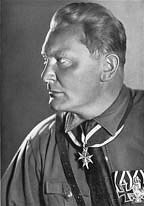
Holocaust studies: hermann goering, Oberbefehlshaber der Luftwaffe (commander in chief of the Air Force)
Originally uploaded by trudeau.
Appointed by Hitler as Plenipotentiary for the Implementation of the Four-Year Plan
September 1, 1939 Hitler appointed him his first successor
June 19, 1940 was made Reichsmarschall (Reich marshal)
Began to lose favor with Hitler during the Battle of Britain because of the decreased effectiveness of the Luftwaffe (German Air Force)
May 9, 1945 captured by U.S. troops
Tried at the Nuremberg Trials
Found guilty on all four counts: conspiracy to commit crimes alleged in other counts, crimes against peace, war crimes, and crimes against humanity
October 15, 1946, two hours before his scheduled execution, he committed suicide by swallowing a cyanide capsule he smuggled into prison.
Th, May 4, Deutschland map quiz and vocab quiz.
New map id's:
Sweden, Norway (Norse men)
Bavaria
Nord Zee
uber
kapell meister, JS Bach
gezundheit
kindergarten
Great Dane
Rudolf Diesel
Opel
Guten tag!
Brief timeline of Adolf Hitler:
1889 Born in Branau, Austria.
1914 - 1918 WWI; serves in German Army. Wins medal for heroism.
1919 Joins Nationalist Socialist German Workers Party (Nazi) in Munich.
1924 Spends year in prison for a failed attempt to take over the government in Munich. In jail writes Mein Kampf.
1932 Wins 38% of vote in national elections; wins seat in parliament.
1933 Becomes Chancellor of Germany through chicanery. Reign of terror through use of police, political troops and secret police - Gestapo - to intimidate opponents. Hitler says "Democracy leads only to communism."
Creates Hitler Youth (Jugend) to extend militarism and totalitarian control.
1935 Laws declare that Jews are lesser beings. Jews sent to death (concentration) and work camps.
1939 Invasion of Poalnd signals beginning of WWII.
1945 Defeat of Germany and suicide of Hitler.
Subscribe to:
Posts (Atom)

